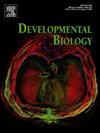基于Micro-CT图像的黑腹果蝇大脑精确分割的深度学习模型
IF 2.1
3区 生物学
Q2 DEVELOPMENTAL BIOLOGY
引用次数: 0
摘要
在过去的十年中,由于扫描平台的增加、操作的简便以及能够精确量化微观结构的软件平台的进步,微型计算机断层扫描(Micro-CT)在生物样本成像方面的使用迅速发展。然而,显微ct图像的人工数据分析可能是费力和耗时的。深度学习提供了简化这一过程的能力,但历史上也存在一些问题,例如需要大量的训练数据,而这在许多Micro-CT研究中往往受到限制。本研究表明,仅使用1-3张成年黑腹果蝇大脑的Micro-CT图像,就可以使用预训练的神经网络和最少的用户知识来训练精确的3D深度学习模型。我们进一步证明了我们的模型的力量,表明它可以扩展到跨不同组织对比染色,扫描仪模型和基因型准确分割大脑。最后,我们展示了该模型如何能够帮助识别基于体积定量的突变体之间的形态相似性和差异性,从而能够快速评估新的表型。我们的模型是免费提供的,可以根据个人用户的需求进行调整。本文章由计算机程序翻译,如有差异,请以英文原文为准。

A deep learning model for accurate segmentation of the Drosophila melanogaster brain from Micro-CT imaging
The use of microcomputed tomography (Micro-CT) for imaging biological samples has burgeoned in the past decade, due to increased access to scanning platforms, ease of operation, and the advance of software platforms that enable accurate microstructure quantification. However, manual data analysis of Micro-CT images can be laborious and time intensive. Deep learning offers the ability to streamline this process but historically has included caveats, such as the need for a large amount of training data, which is often limited in many Micro-CT studies. Here we show that accurate 3D deep learning models can be trained using only 1–3 Micro-CT images of the adult Drosophila melanogaster brain using pre-trained neural networks and minimal user knowledge. We further demonstrate the power of our model by showing that it can be expanded to accurately segment the brain across different tissue contrast stains, scanner models, and genotypes. Finally, we show how the model can assist in identifying morphological similarities and differences between mutants based on volumetric quantification, enabling rapid assessment of novel phenotypes. Our models are freely available and can be adapted to individual users’ needs.
求助全文
通过发布文献求助,成功后即可免费获取论文全文。
去求助
来源期刊

Developmental biology
生物-发育生物学
CiteScore
5.30
自引率
3.70%
发文量
182
审稿时长
1.5 months
期刊介绍:
Developmental Biology (DB) publishes original research on mechanisms of development, differentiation, and growth in animals and plants at the molecular, cellular, genetic and evolutionary levels. Areas of particular emphasis include transcriptional control mechanisms, embryonic patterning, cell-cell interactions, growth factors and signal transduction, and regulatory hierarchies in developing plants and animals.
 求助内容:
求助内容: 应助结果提醒方式:
应助结果提醒方式:


